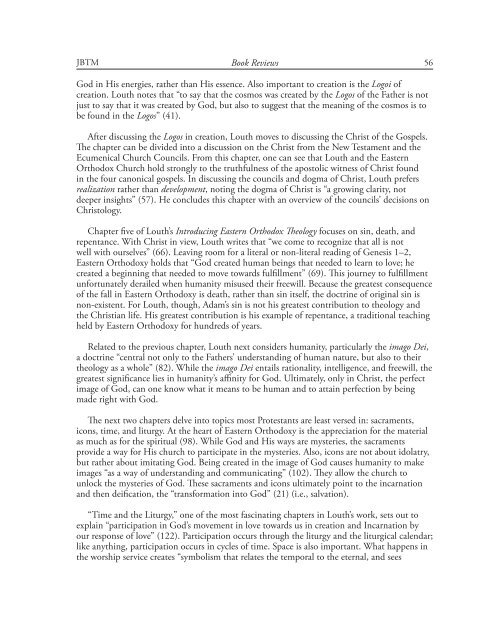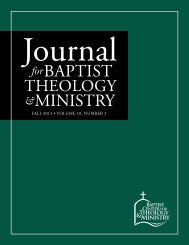Bible Translation as Missions
pTf2MG
pTf2MG
Create successful ePaper yourself
Turn your PDF publications into a flip-book with our unique Google optimized e-Paper software.
JBTM Book Reviews56God in His energies, rather than His essence. Also important to creation is the Logoi ofcreation. Louth notes that “to say that the cosmos w<strong>as</strong> created by the Logos of the Father is notjust to say that it w<strong>as</strong> created by God, but also to suggest that the meaning of the cosmos is tobe found in the Logos” (41).After discussing the Logos in creation, Louth moves to discussing the Christ of the Gospels.The chapter can be divided into a discussion on the Christ from the New Testament and theEcumenical Church Councils. From this chapter, one can see that Louth and the E<strong>as</strong>ternOrthodox Church hold strongly to the truthfulness of the apostolic witness of Christ foundin the four canonical gospels. In discussing the councils and dogma of Christ, Louth prefersrealization rather than development, noting the dogma of Christ is “a growing clarity, notdeeper insights” (57). He concludes this chapter with an overview of the councils’ decisions onChristology.Chapter five of Louth’s Introducing E<strong>as</strong>tern Orthodox Theology focuses on sin, death, andrepentance. With Christ in view, Louth writes that “we come to recognize that all is notwell with ourselves” (66). Leaving room for a literal or non-literal reading of Genesis 1–2,E<strong>as</strong>tern Orthodoxy holds that “God created human beings that needed to learn to love; hecreated a beginning that needed to move towards fulfillment” (69). This journey to fulfillmentunfortunately derailed when humanity misused their freewill. Because the greatest consequenceof the fall in E<strong>as</strong>tern Orthodoxy is death, rather than sin itself, the doctrine of original sin isnon-existent. For Louth, though, Adam’s sin is not his greatest contribution to theology andthe Christian life. His greatest contribution is his example of repentance, a traditional teachingheld by E<strong>as</strong>tern Orthodoxy for hundreds of years.Related to the previous chapter, Louth next considers humanity, particularly the imago Dei,a doctrine “central not only to the Fathers’ understanding of human nature, but also to theirtheology <strong>as</strong> a whole” (82). While the imago Dei entails rationality, intelligence, and freewill, thegreatest significance lies in humanity’s affinity for God. Ultimately, only in Christ, the perfectimage of God, can one know what it means to be human and to attain perfection by beingmade right with God.The next two chapters delve into topics most Protestants are le<strong>as</strong>t versed in: sacraments,icons, time, and liturgy. At the heart of E<strong>as</strong>tern Orthodoxy is the appreciation for the material<strong>as</strong> much <strong>as</strong> for the spiritual (98). While God and His ways are mysteries, the sacramentsprovide a way for His church to participate in the mysteries. Also, icons are not about idolatry,but rather about imitating God. Being created in the image of God causes humanity to makeimages “<strong>as</strong> a way of understanding and communicating” (102). They allow the church tounlock the mysteries of God. These sacraments and icons ultimately point to the incarnationand then deification, the “transformation into God” (21) (i.e., salvation).“Time and the Liturgy,” one of the most f<strong>as</strong>cinating chapters in Louth’s work, sets out toexplain “participation in God’s movement in love towards us in creation and Incarnation byour response of love” (122). Participation occurs through the liturgy and the liturgical calendar;like anything, participation occurs in cycles of time. Space is also important. What happens inthe worship service creates “symbolism that relates the temporal to the eternal, and sees



